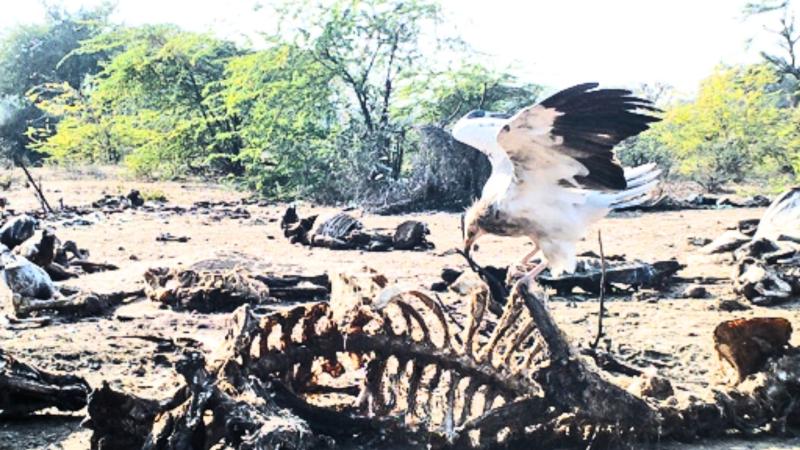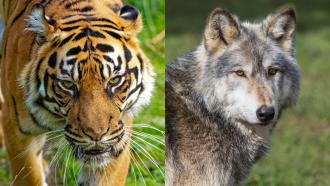
The majestic vultures play a vital role in our ecosystems. Vultures are indispensable obligate scavengers, meaning they rely entirely on consuming animal carcasses for survival. Their unique adaptations allow them to efficiently locate and rapidly consume carrion, playing a critical role in maintaining ecosystem health by preventing the spread of diseases and recycling vital nutrients back into the environment. But in India, their populations have plummeted dramatically, between 90-98% across species, according to the recent State of India’s Birds report.
The decimation is primarily attributed to a veterinary drug called diclofenac, which poisoned them when they fed on treated livestock. This tragic decline has had a ripple effect, leading to a surge in feral dog populations, an alarming rise in rabies cases among humans, and an estimated health cost of $34 billion over 14 years. In this challenging landscape, researchers are now turning their attention to unexpected places, the carcass dumping sites associated with traditional cow shelters, known as gaushalas, to understand how these sites impact the survival of endangered vultures and other scavengers.
A recent study from Gujarat University, Hemchandracharya North Gujarat University, Wildlife and Conservation Biology Research Foundation, Gujarat, Consejo Superior de Investigaciones Científicas (CSIC), Spain, Polish Academy of Sciences, Poland, CSIC - University of Oviedo - Principado de Asturias, Spain and Bhakta Kavi Narsinh Mehta University, Gujarat, sheds light on the competitive world of scavengers at these unofficial feeding grounds. The study reveals both opportunities and significant challenges for conservation.
Did You Know? Vultures have incredibly acidic digestive systems that allow them to safely consume decaying meat, helping to prevent the spread of diseases. |
The research team conducted their study at the Mervada Panjrapol carcass dumping site in Gujarat, an area known for its large livestock population and the presence of endangered Egyptian vultures. Over 79 days, between November 2022 and February 2023, they monitored 32 bovine carcasses, all from adult Holstein Friesian cows weighing between 150-250 kg. Before being left for scavenging, these carcasses were skinned and gutted, a common practice at these sites.
The team set up camera traps 2-3 meters away from each carcass, positioned 1.5 meters above ground, to capture continuous activity. These cameras were motion-triggered and programmed to take two consecutive photos per minute. To understand how different factors influenced scavenging, the researchers categorised carcasses by their decomposition stage – fresh (within one day post-mortem), decay (softening tissues, maggots, strong odour), and dry (bones, hair, desiccated tissues). They also noted whether carcasses were in open areas or under the forest canopy. After collecting over 24,000 images, the team analysed 2,042 feeding events.
The study found that these gaushala livestock dumping sites act as crucial, albeit unintended, feeding grounds for a diverse community of 15 vertebrate scavenger species, including 11 types of birds and four types of mammals. Among these, birds were the most common scavengers, with the endangered Egyptian vulture emerging as the second most frequent visitor, feeding on a remarkable 71.5% of the monitored carcasses. The cattle egret, a smaller bird often seen near grazing livestock, was the most frequent feeder, present at 75% of the carcasses. However, when it came to mammalian scavengers, feral dogs were the undisputed champions, dominating feeding at 68.8% of the carcasses.
They found that the stage of carcass decomposition and its location significantly influenced which scavengers showed up. Egyptian vultures, for instance, showed a clear preference for feeding on decaying carcasses found in open areas. This behaviour stood in stark contrast to feral dogs, which primarily congregated around fresh carcasses located under the forest canopy. This spatial and temporal partitioning suggests a strategy to avoid direct competition.
Crucially, the researchers found that the presence of feral dogs had a significant negative impact on the feeding intensity of Egyptian vultures. When dogs were around, vultures fed less. This effect was even more pronounced for carcasses under the canopy, where dogs were more dominant. Vultures also showed a lower feeding intensity on fresh and dry carcasses compared to those in an advanced state of decomposition, further highlighting their preference for decaying meat. While both species showed overlapping activity peaks during daylight hours, particularly in the morning and late afternoon, the spatial separation (vultures in open areas, dogs under canopy) and carcass condition (vultures on decaying, dogs on fresh) appeared to be stronger factors determining vulture feeding behaviour than simply avoiding each other by time of day.
This study represents a significant step forward in understanding scavenger ecology, particularly in Asia. It also highlights the crucial role of Indian gaushalas and their associated dumping sites for the scavenger community. By focusing on these predictable, yet unofficial, sites, the researchers have filled a critical knowledge gap. However, the findings are based on observations from a single carcass dumping site. This means the results might not fully capture the variability in scavenger communities and their dynamics across different landscapes in India. Future research at multiple sites would be needed to confirm the generality of these findings.
The findings, nevertheless, offer critical insights that can aid conservation efforts. By identifying gaushala dumping sites as important feeding grounds for endangered Egyptian vultures, the study highlights an opportunity to support these threatened birds. However, it also underscores the significant threat posed by feral dogs, which not only compete for food but actively displace vultures, exacerbating the challenges these birds already face from poisoning, habitat loss, and food shortages.
To transform these potential threats into conservation assets, the researchers recommend strategic management approaches. This includes modifying carcass dumping practices, such as placing carcasses in open areas to benefit vultures and in areas inaccessible to dogs. Restricting dog access through physical barriers or fencing at dumping sites is also crucial. Furthermore, designating these and similar dumping sites as Vulture Safe Zones and implementing mandatory veterinary screening of carcasses for harmful drugs would ensure a safe and consistent food supply for vultures. By protecting vultures, we safeguard their vital role in maintaining ecosystem health, recycling nutrients, and reducing public health risks associated with unconsumed carrion and burgeoning feral dog populations. This research provides a roadmap for turning unintended feeding sites into powerful tools for conservation, benefiting both wildlife and human communities.
This article was written with the help of generative AI and edited by an editor at Research Matters.






